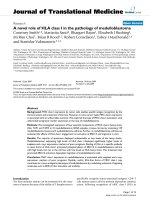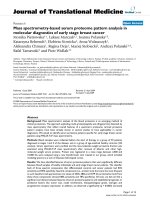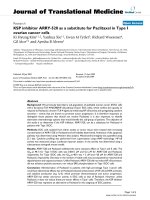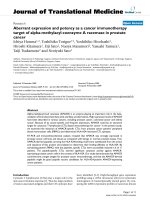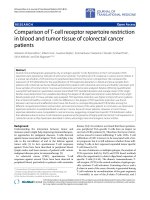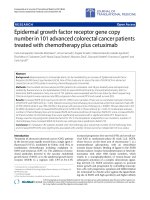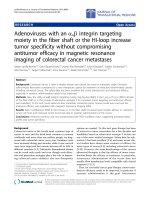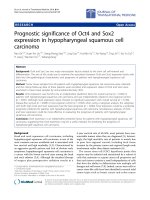Báo cáo hóa học: " Carbon-coated iron oxide nanoparticles as contrast agents in magnetic resonance imaging" potx
Bạn đang xem bản rút gọn của tài liệu. Xem và tải ngay bản đầy đủ của tài liệu tại đây (3.83 MB, 15 trang )
Nanoscale Research Letters
This Provisional PDF corresponds to the article as it appeared upon acceptance. Fully formatted
PDF and full text (HTML) versions will be made available soon.
Carbon-coated iron oxide nanoparticles as contrast agents in magnetic
resonance imaging
Nanoscale Research Letters 2012, 7:44
doi:10.1186/1556-276X-7-44
Ilsu Rhee ()
Sungwook Hong ()
Yongmin Chang ()
Tanveer Ahmad ()
Hongsub Bae ()
Seong-Uk Jin ()
ISSN
Article type
1556-276X
Nano Express
Submission date
1 September 2011
Acceptance date
5 January 2012
Publication date
5 January 2012
Article URL
/>
This peer-reviewed article was published immediately upon acceptance. It can be downloaded,
printed and distributed freely for any purposes (see copyright notice below).
Articles in Nanoscale Research Letters are listed in PubMed and archived at PubMed Central.
For information about publishing your research in Nanoscale Research Letters go to
/>For information about other SpringerOpen publications go to
© 2012 Rhee et al. ; licensee Springer.
This is an open access article distributed under the terms of the Creative Commons Attribution License ( />which permits unrestricted use, distribution, and reproduction in any medium, provided the original work is properly cited.
Carbon-coated iron oxide nanoparticles as contrast agents in magnetic
resonance imaging
Hongsub Bae1, Tanveer Ahmad1, Ilsu Rhee*1, Yongmin Chang2, Seong-Uk Jin2, and Sungwook
Hong3
1
Department of Physics, Kyungpook National University, Daegu, 702-701, Republic of Korea
2
Department of Molecular Medicine and Diagnostic Radiology, Kyungpook University Hospital,
Daegu, 700-422, Republic of Korea,
3
Division of Science Education, Daegu University, Gyeongsan, 712-714, Republic of Korea
*Corresponding author:
Email addresses:
HB:
TA:
IR:
YC:
S-UJ:
SH:
Abstract
Coprecipitated ferrite nanoparticles were coated with carbon using a hydrothermal method. From
transmission electron microscope pictures, we could see that the coated iron oxide nanoparticles
were spherical in shape with an average diameter of 90 nm. The strong bonding of carbon on the
nanoparticle surfaces was checked by noting the C=O and C=C vibrations in Fourier transform
infrared spectra. The spin-lattice relaxation process [T1] and spin-spin relaxation process [T2]
relaxivities of hydrogen protons in the aqueous solution of coated nanoparticles were determined
to be 1.139 (mM·s)−1 and 1.115 (mM·s)−1, respectively. These results showed that the carboncoated iron oxide nanoparticles are applicable as both T1 and T2 contrast agents in magnetic
resonance imaging.
Keywords: iron oxide nanoparticles; carbon-coated nanoparticles; relaxivity; MRI.
PACS: 81.05.y; 76.60.Es; 61.46; 75.50.k; 87.61.
Introduction
Nanostructured materials have attracted a great deal of attention in the development of
biotechnology and medicine [1-3]. Among these nanostructured materials, carbon-coated metal
oxide nanoparticles such as MgO, CaO, ZnO, TiO2, Al2O3, and Fe2O3 are now extensively
1
studied because of their high application potential [4-9]. Recently, much research interest has
been expended on the ferromagnetic iron oxide materials generally used for magnetic data
storage as magnetic toners in xerography, and on the ferrofluids, used as contrast agents in
magnetic resonance imaging [MRI] [10-13].
The carbon coating provides an effective oxidation barrier and prevents corrosion in magnetic
core materials. Hydrophilic carbon coating on iron oxide nanoparticle cores endows better
dispersibility and stability than those shown by bare iron oxide nanoparticles. In general,
different approaches have been employed for the synthesis of carbon coatings, for example,
electric arc discharge, catalytic pyrolysis of organic compounds, and the hydrothermal methods
[14].
In this paper, we report the synthesis of carbon coating on iron oxide (Fe3O4) nanoparticles by a
hydrothermal method proposed by Zhang et al. [14] with some modifications. We evaluated
these coated particles as potential spin-lattice relaxation process [T1] and spin-spin relaxation
process [T2] contrast agent in MRI. We studied the T1 and T2 relaxations of hydrogen protons in
water molecules in an aqueous solution of carbon-coated iron oxide nanoparticles. We found that
the T1 and T2 relaxivities for the aqueous solution of carbon-coated iron oxide nanoparticles were
1.139 and 1.115 (mM·s)−1, respectively. The ratio of these two relaxivities is close to unity. This
result demonstrates that carbon-coated iron oxide nanoparticles are suitable as both T1 and T2
contrast agents in MRI.
Methods
Materials and fabrication
Carbon-coated iron oxide nanoparticles were synthesized by hydrothermal synthetic processes.
Bare iron oxide nanoparticles were formed using the coprecipitation method, in which NaOH
solution was slowly added to a mixed solution of ferric and ferrous chlorides in a glove box
filled with argon gas. During this process, iron oxide nanoparticles were precipitated. These
magnetic particles were separated by a magnet and were washed out by methanol, acetone, and
DI [deionized] water. The collected nanoparticles were dried in a vacuum oven to obtain a
powder sample of nanoparticles for coating. The dried nanoparticles were dispersed in a solution
of 0.5 M glucose for 5 h with sonification. During this process, carbon was coated onto the
surfaces of the nanoparticles. The solution was dried in a vacuum oven filled with argon gas for
4 h. The dried, coated nanoparticles were redispersed in DI water and filtered through a 100-nm
filter paper several times.
Characterization
The particle size distribution and structure of the carbon-coated nanoparticles were checked
using a TEM microscope (TEM, H-7600, Hitachi High-Tech, Minato-ku, Tokyo, Japan). The
hydrodynamic diameter and diffusion constant of the coated nanoparticles in water were
measured with a dynamic light scattering [DLS] particle size analyzer (ELSZ-2, Otsuka
Electronics Co., Ltd., Osaka, Japan). The bonding of carbon onto the iron oxide particles were
confirmed by using Fourier transform infrared spectroscopy [FTIR]. For the relaxivity
2
measurements, aqueous solutions of various nanoparticle concentrations were prepared. The
concentration of nanoparticles in the aqueous solution was measured with an inductively coupled
plasma [ICP] spectrophotometer (IRISAP, Thermo Jarrell Ash, Franklin, MA, USA). The T1 and
T2 relaxation times of hydrogen protons in the aqueous solution of the coated nanoparticles were
measured using an MR scanner (1.5 T Scanner, GE Medical System, Saskatchewan, Canada).
Results and discussion
Figure 1 shows TEM images for the carbon-coated iron oxide nanoparticles. The TEM images
showed that the coated nanoparticles were spherical in shape with an average diameter of 90 nm.
The average hydrodynamic diameter of the carbon-coated nanoparticles measured by a DLS
particle size analyzer was about 200 nm (Figure 2). This diameter was larger than the value
measured by TEM due to both surface coating of the nanoparticles and the water solvation
around the nanoparticles. The diffusion constant of the nanoparticles in water was 9.7265 × 10−9
cm2/s.
The bonding status of carbon on the surfaces of the nanoparticles was checked using the
wavelength-dependent transmittance data obtained using an FTIR spectrometer (Nicolet 380,
Thermo Scientific, Waltham, MA, USA). Figure 3a,b shows the FTIR spectra for bare iron oxide
and carbon-coated iron oxide nanoparticles, respectively. The bands at 1,700 and 1,610 cm−1 in
the spectra of carbon-coated iron oxide are associated with the C=O and C=C vibrations,
respectively, which resulted from the carbonization of glucose during the hydrothermal reaction
[14-15]. The peaks at 1,000 to approximately 1,400cm−1 are attributed to the C–OH stretching
and O–H bending vibrations. The band at 2,920 cm−1 resulted from the stretching vibrations of
O–H.
To demonstrate the T1 and T2 effects in an aqueous solution, MR images for aqueous solutions of
various nanoparticle concentrations were obtained. We prepared ten different samples with
varying concentrations (ranging from 0.427 to 4.27 mM of iron) of nanoparticles in DI water and
put them into microfuge tubes for imaging. One example of the MR images is shown in Figure 4.
In MRI, the signal recorded during the scan is related to the magnetic relaxation processes of the
nuclear spins of the protons in the water molecules in the area of interest. Under a given external
magnetic field (B), the nuclear spins of the protons align with the field, giving rise to a net
magnetization, M. If a radio frequency [rf] pulse is perpendicularly applied to B, the nuclear
spins are excited and start precessing in the plane perpendicular to B. Upon removal of the rf
pulse, the nuclear spins gradually recover to their equilibrium state parallel to B. The recovery of
the equilibrium takes place via two different relaxation mechanisms: the spin-lattice relaxation
process (T1), or in other words, the recovery of the magnetization along the B direction, and the
spin-spin relaxation process (T2), i.e., the loss of signal in the perpendicular plane. The presence
of nanoparticles in the area of interest creates an additional magnetic field (B1) which induces
local field inhomogeneities that significantly increase the speed of the proton transverse
relaxation (decrease of T2), leading to a negative contrast or a darkening of the image.
For T1 measurements, the inversion recovery pulse sequence was used. In this pulse sequence,
3
the relaxation of nuclear spins in the aqueous solution of the magnetic nanoparticles can be
expressed in the following equation:
I ~ M 0 1 − 2e
−
t
T1
(1)
The signal intensities for 35 different times of inversion ranging from 50 to 1,750 ms can be
obtained from these MR images. By applying these data to the intensity function of the MR
signal, we can obtain the T1 relaxation time. Figure 5 shows the plot for two different samples of
nanoparticles with concentrations of 0.427 and 4.27 mM iron.
The Carr-Purcell-Meiboon-Gill pulse sequence with multiple spin echo was used for the T2
measurements. MR images for 30 different times of echo ranging from 10 to 1,700 ms were
obtained. For the signal intensity function of T2 relaxation, the following relationship was used to
determine the T2 relaxation times:
I ~ M 0e
−
t
T2
(2)
Figure 6 shows the plot for two different samples of nanoparticles with concentrations of 0.427
and 4.27 mM iron. The relaxivities 1 of nuclear spins in an aqueous solution of magnetic
Tim
nanoparticles can be expressed as [16]:
1
1
=
+ Ri C ,
Tim Ti
where i = 1 or 2, and
1
Ti
(3)
represents the relaxivity of nuclear spins with no nanoparticle contrast
agent. Also, Ri is the relaxivity of nuclear spins per mM of nanoparticles, and C represents the
concentration of nanoparticles in the aqueous solution.
Figure 7 represents the plots of
1
Ti
and
1
T2
as a function of the concentration of carbon-coated
nanoparticles. The slopes of the straight lines are 1.139 and 1.115 (mM·s)−1, respectively. The
ratio of these two relaxivities was close to unity. This result demonstrates that carbon-coated iron
oxide nanoparticles are suitable as both T1 and T2 agents for MRI.
Conclusions
We synthesized highly water-dispersible carbon-coated iron oxide nanoparticles for use as
contrast agents in MRI. The coated nanoparticles were observed to be spherical with a core-shell
structure in the TEM images, and they showed a uniform size distribution with an average
diameter of 90 nm. The strong bonding of carbon on the nanoparticle surfaces was checked by
4
noting the C=O and C=C vibrations in FTIR spectra. The T1 and T2 relaxation times of hydrogen
protons were measured using an MRI scanner in the aqueous solutions of various concentrations
of nanoparticles ranging from 0.427 to 4.27 mM. The T1 and T2 relaxivities were 1.139 and 1.115
(mM·s)−1, respectively. The ratio of these two relaxivities was close to unity. This result shows
that carbon-coated iron oxide nanoparticles are suitable as both T1 and T2 contrast agents in MRI.
Abbreviations
DLS, dynamic light scattering; FTIR, Fourier transform infrared; ICP, inductively coupled
plasma; MRI, magnetic resonance imaging; TEM, transmission electron microscope.
Competing interests
The authors declare that they have no competing interests.
Authors' contributions
HB and TA synthesized the carbon-coated nanoparticles. SH carried out FTIR and DLS
measurements. YC and SJ performed MRI measurements to determine T1 and T2 relaxivities. IR
designed the experiments and wrote the manuscript with TA. All authors read and approved the
final manuscript.
Acknowledgments
This work was supported by the National Research Foundation of Korea (2010-0021315) and
was also supported by the Basic Science Research Program through the National Research
Foundation of Korea(NRF) grant funded by the Korean government (MEST; 2009-0072413) and
the Nuclear R&D Program (grant code: 20090081817) of the NRF funded by MEST.
References
1. Huang SH, Liao MH, Chen DH: Direct binding and characterization of lipase onto
magnetic nanoparticles. Biotechnol Prog 2003, 19:1095-1100.
2. Josephson L, Perez JM, Weissleder R: Magnetic nanosensors for the detection of
oligonucleotide sequences. Angew Chem Int Ed 2001, 40:3204-3206.
3. Katz E, Sheeney-Haj-Ichia L, Buckmann AF, Willner I: Dual biosensing by magneto
controlled bioelectrocatalysis. Angew Chem Int Ed 2002, 41:1343-1346.
4. Khaleel A, Kapoor PN, Klabunde KJ: Nanocrystalline metal oxides as new adsorbents for
air purification. Nanostruct Mater 1999, 11:459-468.
5. Koper OB, Lagadic I, Volodin A, Klabunde KJ: Alkaline-earth oxide nanoparticles
obtained by aerogel methods Characterization and rational for unexpectedly high
surface chemical reactivities. Chem Mater 1997, 9:2468-2480.
5
6. Klabunde KJ, Stark JV, Koper OB, Mohs C, Park DG, Decker Jiang SY, Lagadic I, Zhang D:
Nanocrystals as stoichiometric reagents with unique surface chemistry. J Phys Chem
1996, 100:12142-12153.
7. Wagner GW, Koper OB, Lucas E, Decker S, Klabunde KJ: Reactions of VX, GD, and HD
with nanosize CaO: autocatalytic dehydrohalogenation of HD. J Phys Chem B 2000,
104:5118-5123.
8. Jang HD, Kim SK, Kim SJ: Effect of particle size and phase composition of titanium
dioxide nanoparticles on the photocatalytic properties. J Nanopart Res 2001, 3:141-147.
9. Miller TM, Grassian VH: Adsorption and decomposition of nitrous oxide on zirconia
nanoparticles [abstract]. Colloids Surf A 1995, 105:113.
10. Kim J, Lee JE, Lee SH, Yu JH, Lee JH, Park TG, Hyeon T: Designed fabrication of a
multifunctional polymer nanomedical platform for simultaneous cancer-targeted
imaging and magnetically guided drug delivery. Adv Mater 2008, 20:478-483.
11. Senpan A, Caruthers SD, Rhee I, Mauro NA, Pan D, Hu G, Scott MJ, Fuhrhop RW, Gaffiney
PJ, Wickline SA, Lanza GM: Conquering the dark side colloidal iron oxide nanoparticles.
ACS NANO 2009, 3:3917-3926.
12. Hong S, Rhee I: Signal loss in the T2-weighted magnetic resonance images by using an
USPIO-particle contrast agent. J Korean Phys Soc 2007, 51:1453-1456.
13. Ahmad T, Rhee I, Hong S, Chang Y, Lee J: Ni-Fe2O4 nanoparticles as contrast agents for
magnetic resonance imaging. J Nanosci Nanotech 2011, 11:5645-5650.
14. Zhang S, Niu H, Hu Z, Cai Y, Shi Y: Preparation of carbon-coated Fe3O4 nanoparticles
and their application for solid-phase extraction of polycyclic aromatic hydrocarbons
from environmental water samples. J Chromatogr A 2010, 1217:4757-4764.
15. Wang Z, Guo H, Yu Y, He N: Synthesis and characterization of a novel magnetic carrier
with its composition of Fe3O4/carbon using hydrothermal reaction. J Magn Magn
Mater 2006, 302:397-404.
16. Okuhata Y: Delivery of diagnostic agents for magnetic resonance imaging. Adv Drug
Delivery Rev 1999, 37:121-137.
6
Figure 1. TEM images of carbon-coated iron oxide nanoparticles. The coated nanoparticles
were spherical in shape with an average diameter of 90 nm.
Figure 2. Particle size distribution. This figure shows the particle size distribution measured by
a DLS particle size analyzer. The average diameter of particles determined from these
measurements is about 200 nm. This diameter is larger than the value measured by TEM due to
both surface coating of the nanoparticles and the water solvation around the nanoparticles. The
diffusion constant of the nanoparticles in water was 9.7265 × 10−9 cm2/s.
Figure 3. FTIR spectra for bare iron oxide (a) and carbon-coated iron oxide (b)
nanoparticles, respectively. The bands at 1,700 and 1,610 cm−1 in the spectra of carbon-coated
iron oxide are associated with the C=O and C=C vibrations, respectively.
Figure 4. MR images for T1 (a) and T2 (b) measurements, respectively. The circular images in
the picture are MR images of aqueous samples of varying concentrations with the units of mM.
While a dose-dependent increase in signal intensity is seen in the T1 measurements, a dosedependent decrease in signal intensity is observed in the T2 measurements.
Figure 5. MR signal intensity for T1 relaxation. MR signal intensity as a function of the time
of inversion is shown for two representative concentrations of nanoparticles. The T1 relaxation in
the 0.427-mM sample was faster than that of the 4.27-mM sample.
Figure 6. MR signal intensity for T2 relaxation. MR signal intensity as a function of the time
of echo is shown for two representative concentrations of nanoparticles. The T2 relaxation in the
4.27-mM sample was faster than that of the 0.427-mM sample.
Figure 7. T1 and T2 relaxivities. This figure represents the plots of
1
T1
and
1
T2
as a function of
the concentration of carbon-coated nanoparticles. The slopes of the straight lines are 1.139 and
1.115 (mM·s)−1, respectively.
7
Figure 2
Figure 3
Figure 4
Figure 5
Figure 6
Figure 7

